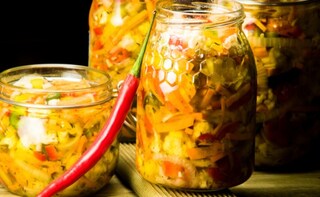Indian food makes for a vast and disparate landscape but there is one thing that bridges the culinary chasm, no matter which part of the country you are from - pickle. The origins of pickle-making may have been shrouded in the mists of time, but it is certain that it is connected with the preservation of food i.e. well before the advent of the refrigerator. Many pickles also developed as a means of combating scarcity and seasonality of produce.According to Usha Prabhakaran's Usha's Pickle Digest, there are thousands of pickles available in India. You can pickle almost anything, from lemon and ginger to brinjal, sorrel leaves (gongura), tendli, karvanda, potatoes, and even beans. The most famous Rajasthaniaachars are made of desert berries (ker and gunda). My friend Maria Shamsi Samiwala tells me about a most intriguing Bohri pickle made out of dry fruits, which is sweet-sour in flavour. "Figs, dates, raisins, alu bukhara (a type of plum) etc go in this tamarind/ jaggery mix with a little red chilli for spice. This pickle is to be licked and savoured on its own," she says.
Non-veg PicklesLess well-known but equally delicious are non-vegetarian pickles. For instance, the Syrian Christians of Kerala prepare fish and beef pickles with a slew of spices and flavourings. The Kodava's (natives of Coorg) most famous aachar is their pork pickle, made with pig skin and fat. The Goan Catholics of course, are famous for their para (fish) and balchao (prawn) pickles, eaten with rice and fish curry. Mangaloreans prepare a spicy, dry Bombay duck pickle. Typical of Pondicherry is its erral urukaiy (prawn pickle). In Lourdes Tirouvanziam-Louis' delighful book, The Pondicherry Kitchen, she also writes about upakandam, preserved meat with salt, chilli and turmeric. "In the past, when people from Pondicherry, Karaikal and Chettinad went to Burma, Vietnam, Malaysia, Africa and France, they carried with them upukandam... The voyage would last three months and the dry meat would come in handy."The Parsis pickle prawn, fish and fish roe, both fresh and dried (yes, even dried fish roe!). Although they use water and brine as pickle bases, the most common pickling agent is Kolah's vinegar, from Navsari. Navsari vinegars are made from sugarcane, date or toddy and give a completely different taste to the pickle.Further in the Northeast, Nagaland, Meghalaya and other states have their own rich tradition of pickling pork and beef. In the North, even Jammu has its own meaty traditions. "In Jammu, we used to make pork pickle, which was delicious. You parboil, then fry the pork in mustard oil. Then you add all the masalas. The fat was the best bit! It would take a long time, nearly a month, to be ready. It was my favourite pickle," says Jamwal.
Advertisement
Non-veg PicklesLess well-known but equally delicious are non-vegetarian pickles. For instance, the Syrian Christians of Kerala prepare fish and beef pickles with a slew of spices and flavourings. The Kodava's (natives of Coorg) most famous aachar is their pork pickle, made with pig skin and fat. The Goan Catholics of course, are famous for their para (fish) and balchao (prawn) pickles, eaten with rice and fish curry. Mangaloreans prepare a spicy, dry Bombay duck pickle. Typical of Pondicherry is its erral urukaiy (prawn pickle). In Lourdes Tirouvanziam-Louis' delighful book, The Pondicherry Kitchen, she also writes about upakandam, preserved meat with salt, chilli and turmeric. "In the past, when people from Pondicherry, Karaikal and Chettinad went to Burma, Vietnam, Malaysia, Africa and France, they carried with them upukandam... The voyage would last three months and the dry meat would come in handy."The Parsis pickle prawn, fish and fish roe, both fresh and dried (yes, even dried fish roe!). Although they use water and brine as pickle bases, the most common pickling agent is Kolah's vinegar, from Navsari. Navsari vinegars are made from sugarcane, date or toddy and give a completely different taste to the pickle.
Advertisement
Advertisement
Advertisement
For the latest food news, health tips and recipes, like us on Facebook or follow us on Twitter and YouTube.
Advertisement
Tags:
